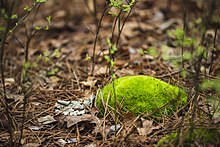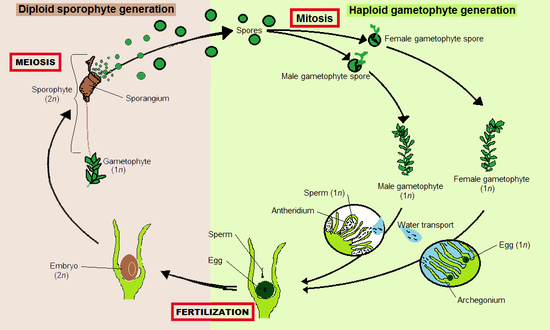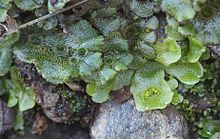Bryophyte


Bryophytes ( (phutón) 'plant'.
Features
The defining features of bryophytes are:
- Their life cycles are dominated by a multicellular gametophyte stage
- Their sporophytes are unbranched
- They do not have a true vascular tissue containing lignin (although some have specialized tissues for the transport of water)[7]
Habitat
Bryophytes exist in a wide variety of habitats. They can be found growing in a range of temperatures (cold arctics and in hot deserts), elevations (sea-level to alpine), and moisture (dry deserts to wet rain forests). Bryophytes can grow where vascularized plants cannot because they do not depend on roots for uptake of nutrients from soil. Bryophytes can survive on rocks and bare soil.[8]
Life cycle

Like all land plants (embryophytes), bryophytes have
Bryophytes are gametophyte dominant,[10] meaning that the more prominent, longer-lived plant is the haploid gametophyte. The diploid sporophytes appear only occasionally and remain attached to and nutritionally dependent on the gametophyte.[11] In bryophytes, the sporophytes are always unbranched and produce a single sporangium (spore producing capsule), but each gametophyte can give rise to several sporophytes at once.
Liverworts, mosses and hornworts spend most of their lives as gametophytes.
Fertilized eggs become zygotes, which develop into sporophyte embryos inside the archegonia. Mature sporophytes remain attached to the gametophyte. They consist of a stalk called a seta and a single sporangium or capsule. Inside the sporangium, haploid spores are produced by
The sporophyte develops differently in the three groups. Both mosses and hornworts have a meristem zone where cell division occurs. In hornworts, the meristem starts at the base where the foot ends, and the division of cells pushes the sporophyte body upwards. In mosses, the meristem is located between the capsule and the top of the stalk (seta), and produces cells downward, elongating the stalk and elevating the capsule. In liverworts the meristem is absent and the elongation of the sporophyte is caused almost exclusively by cell expansion.[13]
Sexuality
The arrangement of antheridia and archegonia on an individual bryophyte plant is usually constant within a species, although in some species it may depend on environmental conditions. The main division is between species in which the antheridia and archegonia occur on the same plant and those in which they occur on different plants. The term monoicous may be used where antheridia and archegonia occur on the same gametophyte and the term dioicous where they occur on different gametophytes.[14]
In
Monoicous plants are necessarily hermaphroditic, meaning that the same plant produces gametes of both sexes.[14] The exact arrangement of the antheridia and archegonia in monoicous plants varies. They may be borne on different shoots (autoicous), on the same shoot but not together in a common structure (paroicous or paroecious), or together in a common "inflorescence" (synoicous or synoecious).[14][15] Dioicous plants are unisexual, meaning that an individual plant has only one sex.[14] All four patterns (autoicous, paroicous, synoicous and dioicous) occur in species of the moss genus Bryum.[15]
Classification and phylogeny


Traditionally, all living land plants without vascular tissues were classified in a single taxonomic group, often a
The three bryophyte
Monophyletic view
The favored model, based on amino acids phylogenies, indicates bryophytes as a monophyletic group:[23]
| embryophytes |
| ||||||||||||||||||
Consistent with this view, compared to other living land plants, all three lineages lack vascular tissue containing lignin and branched sporophytes bearing multiple sporangia. The prominence of the gametophyte in the life cycle is also a shared feature of the three bryophyte lineages (extant vascular plants are all sporophyte dominant). However, if this phylogeny is correct, then the complex sporophyte of living vascular plants might have evolved independently of the simpler unbranched sporophyte present in bryophytes.
Paraphyletic view
|
bryophytes |

In this alternative view, the Setaphyta grouping is retained, but hornworts instead are sister to vascular plants.[33] (Another paraphyletic view involves hornworts branching out first.)[31]
Traditional morphology
Traditionally, when basing classifications on morphological characters, bryophytes have been distinguished by their lack of vascular structure. However, this distinction is problematic, firstly because some of the earliest-diverging (but now extinct) non-bryophytes, such as the
| land plants |
| |||||||||||||||
Evolution
There have probably been several different terrestrialization events, in which originally aquatic organisms colonized the land, just within the lineage of the Viridiplantae.[39] Between 510–630 million years ago, however, land plants emerged within the green algae.[40] Molecular phylogenetic studies conclude that bryophytes are the earliest diverging lineages of the extant land plants.[41][1][42][43] They provide insights into the migration of plants from aquatic environments to land. A number of physical features link bryophytes to both land plants and aquatic plants.[44]
Similarities to algae and vascular plants
Green algae, bryophytes and vascular plants all have chlorophyll a and b, and the chloroplast structures are similar.[45] Like green algae and land plants, bryophytes also produce starch stored in the plastids and contain cellulose in their walls.[45] Distinct adaptations observed in bryophytes have allowed plants to colonize Earth's terrestrial environments. To prevent desiccation of plant tissues in a terrestrial environment, a waxy cuticle covering the soft tissue of the plant may be present, providing protection. In hornworts and mosses, stomata provide gas exchange between the atmosphere and an internal intercellular space system. The development of gametangia provided further protection specifically for gametes, the zygote and the developing sporophyte.[46] The bryophytes and vascular plants (embryophytes) also have embryonic development which is not seen in green algae.[45] While bryophytes have no truly vascularized tissue, they do have organs that are specialized for transport of water and other specific functions, analogous for example to the functions of leaves and stems in vascular land plants.[45]
Bryophytes depend on water for reproduction and survival. In common with ferns and lycophytes, a thin layer of water is required on the surface of the plant to enable the movement of the flagellated sperm between gametophytes and the fertilization of an egg.[46]
Comparative morphology
Summary of the morphological characteristics of the gametophytes of the three groups of bryophytes:
| Liverworts | Mosses | Hornworts | |
|---|---|---|---|
| Structure | Thalloid or foliose
|
Foliose | Thalloid |
| Symmetry | Dorsiventral or radial | Radial | Dorsiventral |
Rhizoids
|
Unicellular | Pluricellular | Unicellular |
| Chloroplasts/cell | Many | Many | One |
| Protonemata | Reduced | Present | Absent |
| Gametangia ( archegonia )
|
Superficial | Superficial | Immersed |
Summary of the morphological characteristics of the sporophytes of the three groups of bryophytes:
| Liverworts | Mosses | Hornworts | |
|---|---|---|---|
Stomata
|
Absent | Present | Present |
| Structure | Small, without chlorophyll | Large, with chlorophyll | Large, with chlorophyll |
| Persistence | Ephemeral | Persistent | Persistent |
| Growth | Defined | Defined | Continuous |
| Apical growth[47] | Absent | Present | Absent |
| Seta | Present | Present | Absent |
Capsule form
|
Simple | Differentiated (operculum, peristome) |
Elongated |
| Maturation of spores | Simultaneous | Simultaneous | Gradual |
| Dispersion of spores | Elaters | Peristome teeth | Pseudo-elaters |
| Columella | Absent | Present | Present |
| Dehiscence | Longitudinal or irregular | Transverse | Longitudinal |
Uses
This article is in prose. is available. (April 2017) |
Environmental
- Soil Conditioning
- Bioindicators
- Moss gardens
- Pesticides
Characteristics of bryophytes make them useful to the environment. Depending on the specific plant texture, bryophytes have been shown to help improve the water retention and air space within soil.[48] Bryophytes are used in pollution studies to indicate soil pollution (such as the presence of heavy metals), air pollution, and UV-B radiation.[48] Gardens in Japan are designed with moss to create peaceful sanctuaries.[48] Some bryophytes have been found to produce natural pesticides. The liverwort, Plagiochila, produces a chemical that is poisonous to mice.[48] Other bryophytes produce chemicals that are antifeedants which protect them from being eaten by slugs.[48] When Phythium sphagnum is sprinkled on the soil of germinating seeds, it inhibits growth of "damping off fungus" which would otherwise kill young seedlings.[49]

Commercial
- Fuel
- Packaging
- Wound Dressing
Peat is a fuel produced from dried bryophytes, typically Sphagnum. Bryophytes' antibiotic properties and ability to retain water make them a useful packaging material for vegetables, flowers, and bulbs.[48] Also, because of its antibiotic properties, Sphagnum was used as a surgical dressing in World War I.[48]
See also
- Plant sexuality
- List of British county and local bryophyte floras
- Thallophyta
References
- ^ S2CID 10956647.
- ISBN 978-0-07-352422-1.
- ^ "Bryophytes (Mosses and liverworts) — The Plant List". theplantlist.org. Retrieved 2017-04-11.
- ^ "What are Bryophytes". Southern Illinois University Carbondale. Archived from the original on 2018-10-19. Retrieved 2009-05-31.
- ISBN 978-0-511-54013-4.
- ^ a b Schimper, W.P. (1879). "Bryophyta". In Zittel, K.A. (ed.). Handbuch der Palaeontologie. Vol. 2. R. Oldenbourg.
- PMID 23462277.
- ^ Lepp, Heino (28 February 2008). "Habitats". Australian Bryophytes. Australian National Botanic Gardens.
- PMID 22356739.
- ^ C.M. Sean Carrington (2013-11-04). "The Bryophytes". The University of the West Indies. Archived from the original on 2020-02-05. Retrieved 2020-03-05.
- PMID 26905464.
- S2CID 11555211.
- ISBN 9780128098059.
- ^ a b c d e Glime, J.M. & Bisang, I. (2014). "Sexuality: Its Determination (Ch. 3-1)" (PDF). In Glime, J.M. (ed.). Bryophyte Ecology. Vol. 1 Physiological Ecology. Michigan Technological University and the International Association of Bryologists. Retrieved 2014-11-09.
- ^ ISBN 9780521285360. (Watson uses the "oecy" terms rather than the "oicy" terms.)
- ^ "Phylum Bryophyta – Hierarchy". Taxonomicon.
- ^ S2CID 53240320.
- ^ Smith, G.M. (1955). Cryptogamic Botany. Vol. 2 (2nd ed.). New York: McGraw-Hill.
- S2CID 41403901.
- .
- S2CID 13509400.
- .
- ^ PMID 24399481.
- ^ S2CID 3269165.
- PMID 31645766.
- PMID 32042158.
- ^ S2CID 215798377.
- PMID 32170292.
- PMID 32760416.
- PMID 33871608.
- ^ PMID 32377448.
- ^ "GLOSSARY B". Archived from the original on 2009-04-02. Retrieved 2009-03-26.
- ^ S2CID 92198979.
- PMID 20152915.
- S2CID 212641738.
- ISBN 978-1-56098-730-7.
- S2CID 3866183.
- PMID 21652317.
- .
- S2CID 235312105.
- .
- PMID 20969798.
- PMID 21613131.
- S2CID 238588736.
- ^ a b c d Evert, Ray; Eichhorn, Susan (2013). Biology of Plants. W.H.Freeman and Company Publishers.
- ^ a b Purcell, Adam. "Bryophytes". Basic Biology.
- ^ How was apical growth regulated in the ancestral land plant? Insights from the development of non-seed plants
- ^ a b c d e f g Glime, Janice. "Economic and Ethnic Uses of Bryophytes" (PDF). harvard.edu.
- .
Bibliography
- Lesica, P.; McCune, B.; Cooper, S. V.; Hong, W. S. (1991). "Differences in lichen and bryophyte communities between old-growth and managed second-growth forests in the Swan Valley, Montana". Canadian Journal of Botany. 69 (8): 1745–1755. doi:10.1139/b91-222.
External links
- Andrew's Moss Site Photos of bryophytes
- 27-May-2013 Centuries-old frozen plants revived, 400-year-old bryophyte specimens left behind by retreating glaciers in Canada are brought back to life in the laboratory.
- Farge, Catherine La; Williams, Krista H.; England, John H. (22 May 2013). "Regeneration of Little Ice Age bryophytes emerging from a polar glacier with implications of totipotency in extreme environments". Proceedings of the National Academy of Sciences. 110 (24): 9839–9844. PMID 23716658.
- Magill, R. E., ed. (1990). Glossarium polyglottum bryologiae. A multilingual glossary for bryology. Monographs in Systematic Botany from the Missouri Botanical Garden, v. 33, 297 pp. Online version: Internet Archive.
